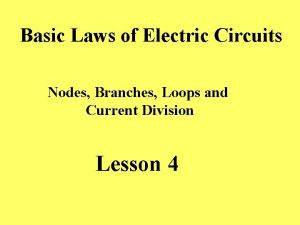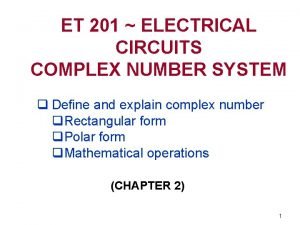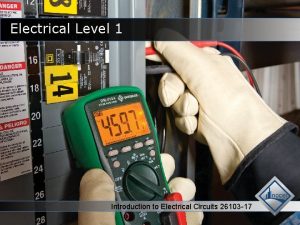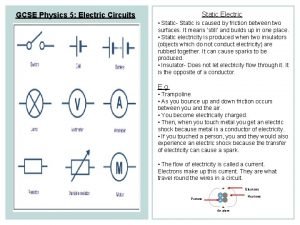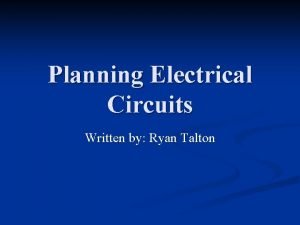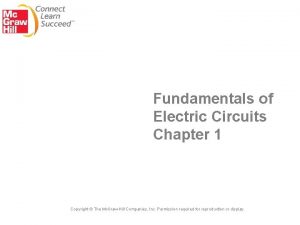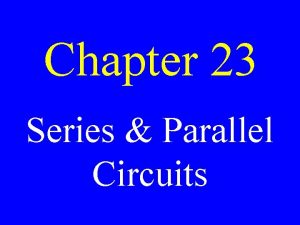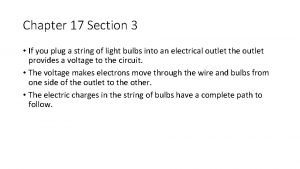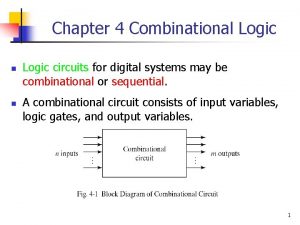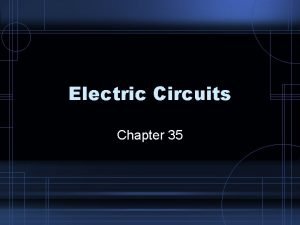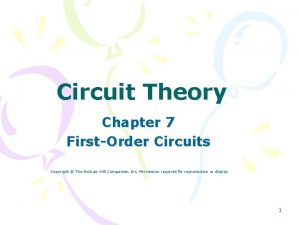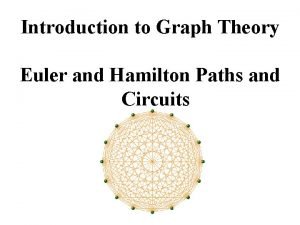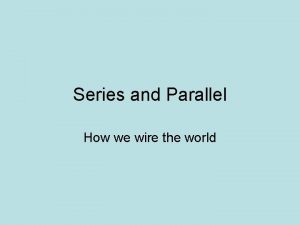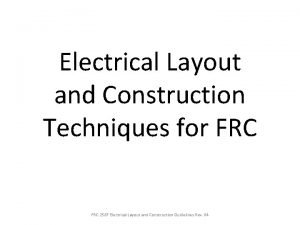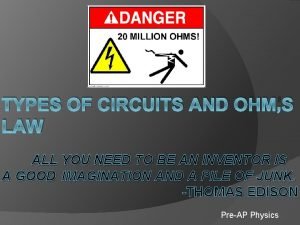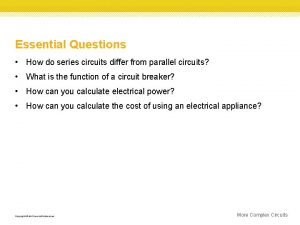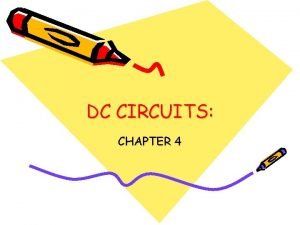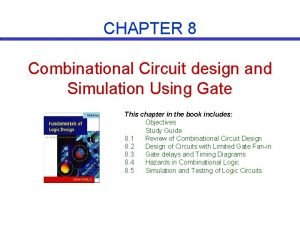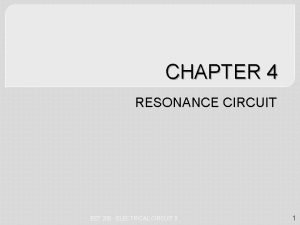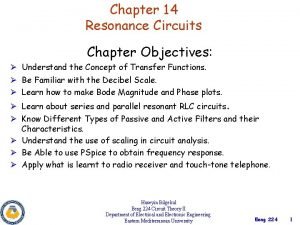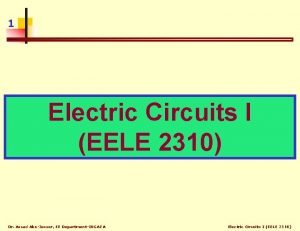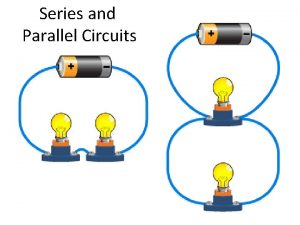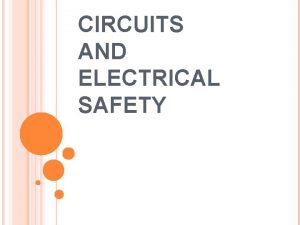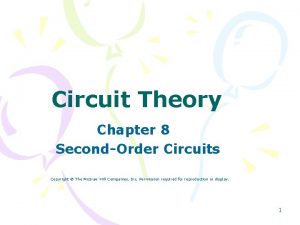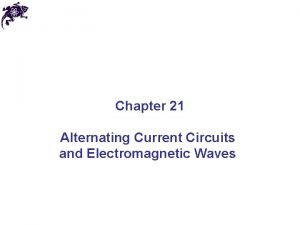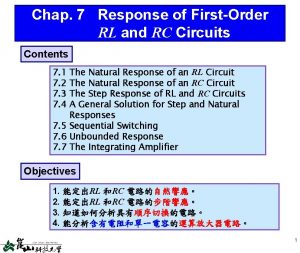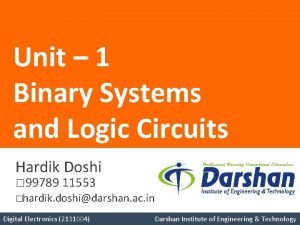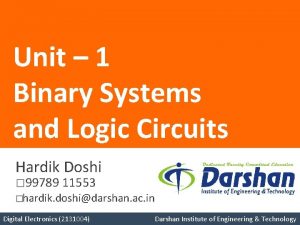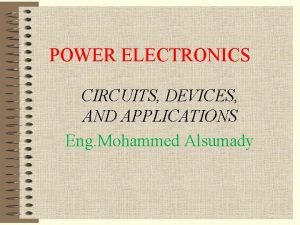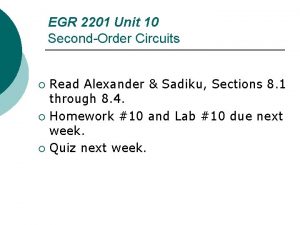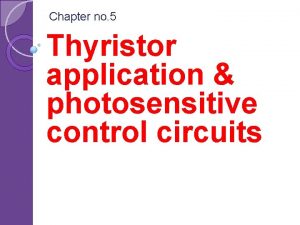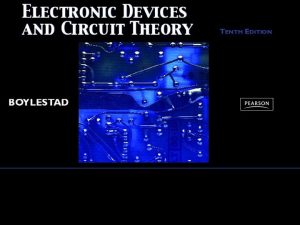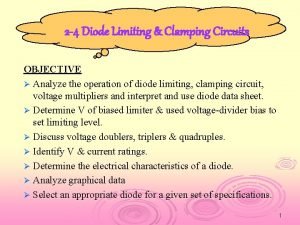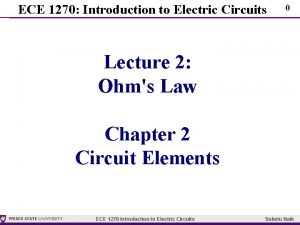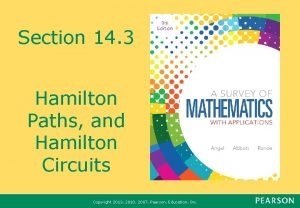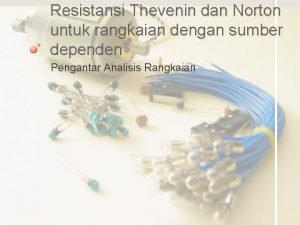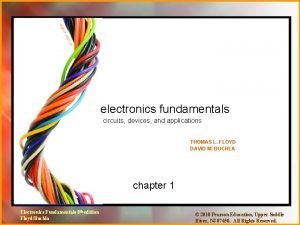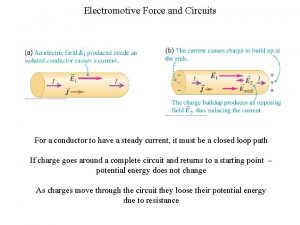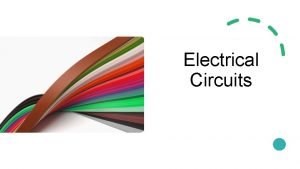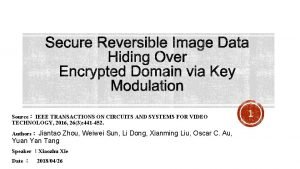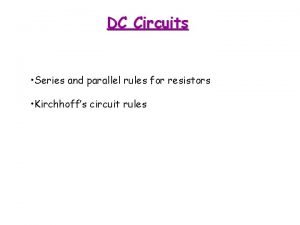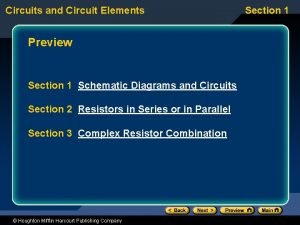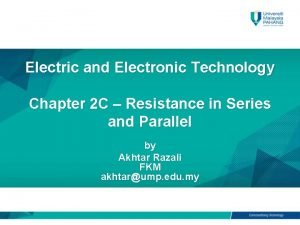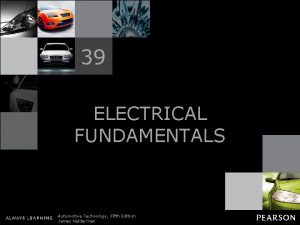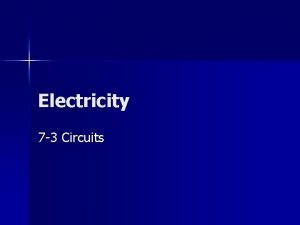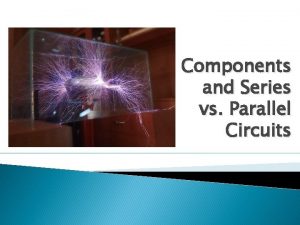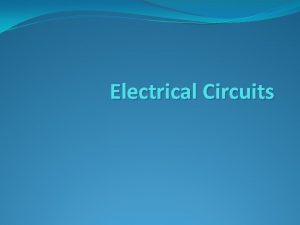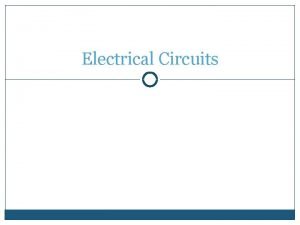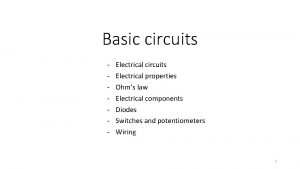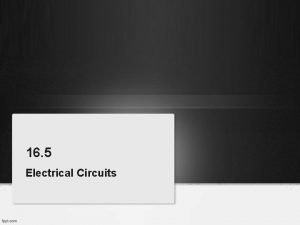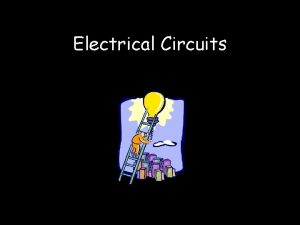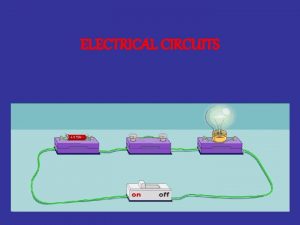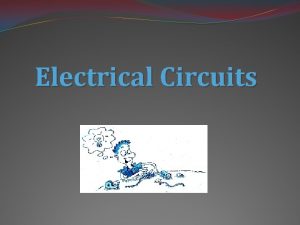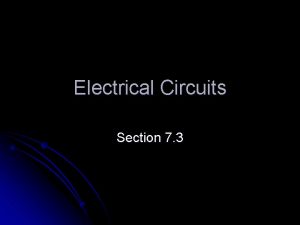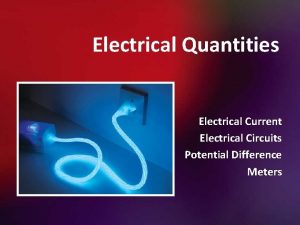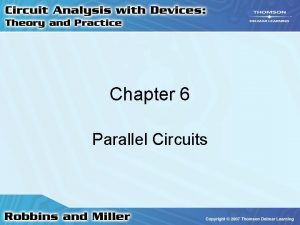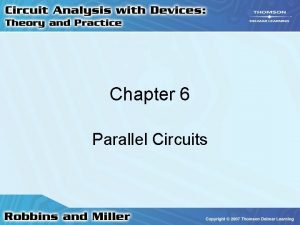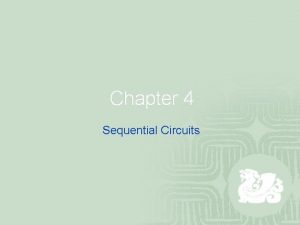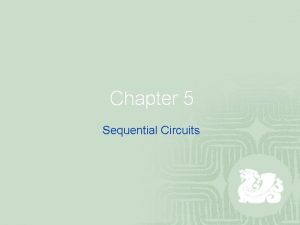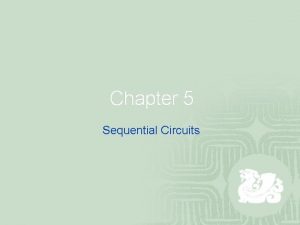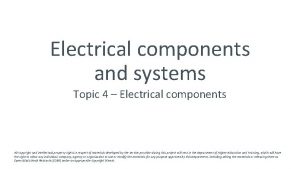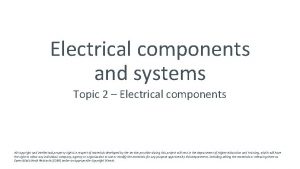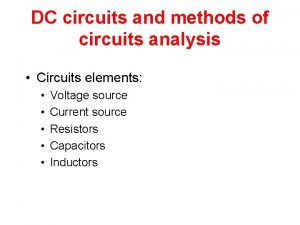Chapter 2 Electrical Components and Circuits Electrical Components



































































- Slides: 67

Chapter 2. Electrical Components and Circuits

Electrical Components: Electric current ; the motion of a charge through a medium. Electric units ; the unit of charge (or quantity of electricity) ; C(coulomb) → 0. 001111800 g of silver ion → Charge for reduction to silver metal. 1 Faraday = 9. 649 x 104 coulombs 1 Faraday ; Deposition of Ag 107. 868 g of 1 gram equivalent ↳ (6. 02 x 1023 charged particle), I = d. Q/dt (Q : charge, A : ampere)

2 A Direct-Current Circuits and Measurements - Direct current ; 전하가 시간에 비례 - Alternating current ; 전하가 주기적으로 변화하는 것. 2 A-1 Laws of Electricity 두 점 사이의 electrical potential (V) ; 공간의 한 점에서 다른 점까지 1개의 전하를 움직이는데 는 일. V ; volt → joule/conlomb (W/Q = V) = (I․R) R ; ohm → R의 단위 Ω(R = ρℓ/A) ↳ Ohm's law G ; 저항의 역수(electrical conductance) Ω-1, S I ; Ampere P ; Electrical power. joules/sec, W P = dw/dt = V․d. Q/dt = V․I P = (I․R)․I = I 2 R. joule's law

Kirchhoff's Laws - Current low ; the algebraic sum of currents around any point in a circuit is zero. -Voltage low ; the algebraic sum of the voltages around a closed electrical loop is zero. Power Law P = IV P = I 2 R = V 2/R

2 A-2 Direct-Current Circuits 1) Series circuits Fig 2 -1. A battery, a switch, & three resistors in series.

ⓐ 점 D에서 kirchhoff's law 적용 I 4 - I 3 = 0 or I 4 = I 3 , I 3 = I 2 at point C. * the current is the same at all points I = I 1 = I 2 = I 3 = I 4 ⓑ Voltage low V - V 3 - V 2 - V 1 = 0 or V = V 1 + V 2 + V 3 by ohm's law V = 1(R 1 + R 2 + R 3) = IReq ∵ Req = R 1 + R 2 + R 3 IR 1 = V 1 , V 2 = IR 2 , V 3 = IR 3 V 1 = I 1 R 1 = IR 1 (2 -9)

Voltage dividers ; Fig 2 -3 a → series connection of resistor ↳ discrete increment

- Potentiometer; continuously variable

2) Parallel Circuits Resistors in parallel at point A Kirchhoff's current law to point A I 1 + I 2 + I 3 - It = 0 It = I 1 + I 2 + I 3

- Applying Kirchhoff's voltage law I 1 = V/R 1 V - I 1/R 1 =0 V= I 1 R 1 I 2 = V/R 2 V - I 2/R 2 =0 V = I 2 R 2 I 3 = V/R 3 V = I 3 R 3 It = I 1 + I 2 + I 3에 위식 代入 V V It = --- + --Rp so that R 1 R 2 R 3 1 1 --- = --- + --Rp G=1/R V 1 = V 2 = V 3 = V R 1 R 2 R 3 G p = G 1 + G 2 + G 3 - Parallel resistances create a current divider. I 1 V/R 1 1/R 1 G 1 --- = ----- = --It V/Rp 1/Rp Gp Rp G 1 or I 1 = It --- = It --R 1 Gp

(Ex. 2 -1) Calculate a) the total resistance, b) the current from the battery, c) the current present in each of the resistors, and d) the potential drop across each of the resistors.

1 1 1 a) ( --- + --- ) = --R 2 R 3 R 2, 3 1 1 1 3 --- = --- + --- = --R 20 40 40 b) The current ; V = I·R R 2, 3 = 13. 3Ω V 15 I = ----- = 0. 67 A Rs 22. 3 c) V = V 1 + V 2 + V 3 V 1 = I 1 R 1 = 6. 03 I = I 2 = I 3 이므로 9. 0 V 1 = 15 x ------ = 6. 0 V (9. 0 + 13. 3) 13. 3 V 2 = V 3 = V 2, 3 = 15 x ------ = 9. 0 V 22. 3 d) R 1에서 I 1 = I = 0. 67 A I 2 = 9. 0/20 = 0. 45 A I 3 = 9. 0/40 = 0. 22 A

2 A-3 Direct Current, Voltage, and Resistance Measurements Digital Volmeters and Multimeters D’Arsonval moving-coil meter Digital Voltmeters and Multimeters. Power Source, display, A/D converter

The Loading Error in Potential Measurements The Loading Error in Current Measurements

See equations 2 -19 and 2 -20

2 B Alternating current Circuits Alternating voltage and current: 화가 계속 반복되는 전압 또는 전류. 시간에 따라 방향과 크기가 변화하며 똑같은 변 ( the simplest alternating waveform is sine- wave volt or current. ) - Period (Tp); The time required for the completion of one cycle - Cycle; one complete revolution - Frequency(f) [HZ]; time number of cycles per second f = 1/tp (2 -21)

Sinusoidal signals ;


2 B-1 Sinusoidal Signals The AC: produced by rotation of a coil in a magnetic field. A pure sine wave → 일정한 각속도로 회전 하는(시계방향) IP의 vector로 표시. (여기서 Ip : amplitude. ) 주기 t 내에 2π radian 의 속도로 회전 할 때 ω = 2π/tp = 2πf Any time t에서 instantaneous value → Vpsin ωt Vp; maximum or peak voltage; the amplitude 순간 전류 : ⅰ= Ip sin ωt = Ip sin 2πft 순간 전압 : v = Vp sin ωt = Vp sin 2πft Out of phase by 90 o Phase difference : phase angle(φ) 일반식 ; ⅰ= Ip sin(ωt + φ) = Ip sin(2πft + φ)

(rms current & voltage) ; DC, AC의 크기비교 ; 두 전류에 의한 저항에서 야기되는 Joule heat DC = the effective value of a sinusoidal, current Report, heating effect of AC is calculated by averaging I 2 R losses even complete cycle


2 B-2 Reactance in Electrical Circuits Reactance - capacitance : capacitor inductance : inductor Use ; ① converting alternating current to DC or the converse ② discriminating among signals of different frequencies or separating ac & dc signals. Capacitors 구성; a pair of conductors separated by a thin layer of a dielectric substance

Position 1 Figure 2 -8. (a) A series RC circuit. Time response of circuit when switch S is (b) in position 1 and (c) in position 2. Position 2

2 B-3 Capacitors and Capacitance 1) Capacitance ① a momentary current ② current ceases → to be changed ③ switch을 2로 discharge. Capacitor ① 과 ② 사이에서 switch off; 측면 전하가 저장 The quantity of electricity Q → 판 넓이, 모양, 공간, 절연체 의 유전상수에 의해 결정

1 Faraday ; 1 V의 전위치에 의해 양극판에 축적된 전하의 크기가 1 C일 때의 capacitance. ( μF, PF) V = 1/C ∫idt = 1/C∫ Ip sin wt dt = -1/wc Ip cos wt = 1/wc Ip sin(wt - π/2) ∵ Vp = 1/wc Ip, V = (1/wc) I 1/wc = Xc → capacitive reactance 단위 Ω Xc = -1/wc, V =│Xc│I


Rate of current changes in an RC circuit By Kirchhoff 의 voltage law Vi = V c + V R Vi = q/C + i. R Vi = constant

Rate of Voltage Change in an RC circuit use Ohm’s law to eq. 2 -35 Phase relations between current and voltage in an RC circuit

Rate of Current & Potential Change across RL circuit. RC circuit와 동일한 방법으로 처리 VR = Vi( I - e-t. R/L ) VL = Vi e-t. R/L L/R : time constant

2 B-4 Response of Series RC Circuits to Sinusoidal Inputs Response of series RC & RL circuits to sinusoidal inputs signal (Vs)

Ip

(1/ωC = Xc) At sufficiently high frequencies & capacitance, φ become negligible & I & v are in phase. 1/ωC은 저항 R에 비해 무시 可. ↳ 전류가 잘 흐름 At very low frequencies, the phase angle; π/2

Voltage, current and phase Relationships for series RL circuit

Figure 2 -9

Capacitive & Inductive Reactance ; impedance Xc = 1/w. C = 1/2πf. C XL = w. L = 2πf. L Impedance Z ; 교류회로에서 전압과 전류의 크기의 비(직류회로의 저항에 해당) At, RC circuit Z = √R 2 + Xc 2 Z = √R 2 + XL 2 Ip = Vp/Z 저항과 차이점 : ① frequency dependent ② current와 voltage 사이에 phase difference

Figure 2 -10

<Vector diagrams for Reactive Circuits> V가 ⅰ보다 90°늦다. at capacitance V가 ⅰ보다 90°빠르다. at inductance Z = √R 2 + (XL - Xc)2 Z = √R 2 + Xc 2 , φ = -arctan Xc/R Z = √R 2 + XL 2 , φ = -arctan XL/R Z = √R 2 + (XL + Xc)2 φ = -arctan (XL + Xc) / R (XL > Xc 인 경우) ex) ① peak current ② voltage drop Z = √(50)2 + (40 - 20)2 = 53. 8Ω Ip = 10 v/53. 8 = 0. 186 A Vc = 0. 186 x 20 = 3. 7 V VR = 0. 186 x 50 = 9. 3 V VL = 0. 186 x 40 = 7. 4 V

2 B-5 Filters Based on RC Circuits High-pass & Low-Pass Filters RC & RL circuits → low f component를 지나는 동안 high-f signals을 낮추기 위해 filter로 사용 (low pass filter) or 역이 성립. ① RC circuit에서 high-pass filter Vo : across the resistor R

(a) high pass filter and (b)low-Pass Filters

Low pass filter

2 B-6 The Response of RC Circuits to Pulsed Inputs <Resonant Circuits> impedance Z가 최소 즉 XL = Xc 일 때 전류 I = E/Z = E/R ↳ the condition of Resonance resonant frequency fo ; 1/2πfo. C = 2πfo. L ∵ fo = 1/2π√LC ex) (Vp)i = 15. 0 V (peak voltage), L = 100 m. H, R = 20Ω, C = 1. 200μF.

Figure 2 -13


2 B-7 Alternating Current, Voltage, and Impedance Measurements Parallel Resonance Filters Xc = XL fo = 1/2π√LC Z of the parallel circuit Z = √R 2 + (XLXc/Xc-XL)2 At parallel circuit at resonance → Z는 최대 → maximum voltage drop 生 → tank circuit Behavior of RC Circuits with pulsed inputs RC 회로에 pulse 加 → various form (with of pulse time const) 사이의 관계에 의존 Simple Electrical Measurements Galvanometers → DC의 전류, 저항 측정 원리 : the current in duceol motion of a coil suspended in a yixed magnetic yiedd. ⇒ D'arsonval movement or coil. He Ayrton Shunt : to vary the range of a galvanometers p 29. 예제 참조 ☆ measurement of current and voltage.


Semiconductor Device

2 C Semiconductors and Semiconductor Devices Semiconductors -Electronic circuits contain one or more nonlinear devices such as transistors, semiconductor diodes, and vacuum or gas-filled tubes. -Nonlinear components ; rectification (from ac to dc ) amplitude modulation or frequency modulation vacuum tube → Semiconductor based diodes and transistors → integrated circuits (Tr, R, C & conductor) -Semiconductor 장점 : low cost, low power consumption, small heat generation, long life and compactness.

2 C-1 Properties of silicon & germanium semiconductors. -Sufficient thermal agitation occurs at room temp. to liberate an occasional electron from its bonded state, leaving it free to more through the crystal lattice and thus to conduct electricity. -Hole : positively charged region. -Electron: negatively charged region. -Hole & electron 의 이동방향 반대. -Doping of arsenic or antimony (Group Ⅴ) → n type of indium or gallium (Group Ⅲ) → p type Positive holes are less mobile them free electrons. Conductivity of n type >conductivity of p type.

2 C-2. Semiconductor Diodes Pn junction motion → diode is a nonlinear device that has greater conductance in one direction than in another. Figure 2 -15 A pn junction diode (c) forward - bias (d) reverse - bias → depletion layer 생성 : conductance 10 -6~10 -8

Figure 2 -16 I - V cures for semiconductor Diodes The voltage at which the sharp increase in current occurs under reverse bias is called the Zener breakdown voltage.

2 C-3 Transistors : Amplifying device -Bipolar -Field effect transistor. ① Bipolar Tr. : pnp, npn tr.

Figure 2 -17. The mechanism of amplification with a bipolar transistor. pnp on ∽ n layer ~ 0. 02 mm thickness, p>>n layer. (수백배 이상), ∴The concentration of holes in p >> that of electrons in n layer

Figure 2 -18.

① P-type emitter junction 에서 hole 생성 ② ①번의 hole 이 very thin n-type base 로 이동 - electron 과 결합 (base current IB유발) ③ 대부분의 hole 은 base를 통해 drift 되어 collector junction 으로 attracting ④ 여기서 power supply로부터 나온 electron 과 combined 되어 전류 흐 름 (Ic) The no of current carrying holes is a fixed multiple of the number of electrons supplied by the input base current.

Field Effect Transistors (FET) FET - The insulated gate field effect transistor. → 109~1014 Ω 의 imput impedence → MOSFET (metal oxide semiconductor FET) n- chanel MOSFET The gate is a cylindrical p-type semiconductor surrounding a center core of n -doped material called the channel. Two isolated n regions are formed in a p-type substrate. 위의 n. p regions 을 silicon dioxide로 insulating

Figure 2 -19.

(n-channel junction FET) current enhancement in brought about by application of a positive potential to the gate: Gate 에 “+" induce “-“ substrate channel below the layer of Si. O 2 Depletion mode →in the absence of a gate voltage reverse bias is applied to the gate the supply of electrons in the channel is depleted. → channel 저항 증가→전류감소. The width of the reverse biased gate junction determined (the wide of the channel and consequently). The magnitude of the current between source and drain.

2 D Power Supplies and Regulators most ps contains a voltage regulator. Figure 2 -20.

2 D-1 Transformers VX = 115 X N 2/N 1 N 2 and N 1 are the no of turns in the secondary and primary coils. 2 D-2 Rectifiers ①Half wave rectifier ②Full wave rectifier ③bridge rectifier ①: ②; 그림 ③ 그림

Figure 2 -21.

D 2, D 3 → conduct on the alternate D 4 and D 1 conduct Since two diodes are in series with the load, the output voltage is reduced by twice the diode drop. Figure 2 -22.

2 D-2 Rectifiers and Filters Figure 2 -23. In order to minimize the current fluctuations. L section filter : S 은 직렬 C는 병렬 연결. ⇒ peak to peak ripple can be reduced.

2 D-3 Voltage Regulators Figure 2 -24. Zener diode : breakdown condition 하에서 작동. Under breakdown condition, a current change of 20 to 30 m. A may result from a potential change of 0. 1 V or less.

2 E Readout Devices Figure 2 -25. Basic analog oscilloscope component

2 E-1 Oscilloscopes Cathode-Ray Tubes Horizontal and vertical Control Plates. Trigger Control. Figure 2 -26. Schematic of a CRT

2 E-2 Recorders Figure 2 -27. Schematic recording potentiometer of self-balancing

2 E-3 Alphanumeric Displays 2 E-4 Computers
 Current in a parallel circuit
Current in a parallel circuit Two types of circuits
Two types of circuits Node electrical circuit
Node electrical circuit Et 201
Et 201 Nccer introduction to electrical circuits
Nccer introduction to electrical circuits Electrical circuits gcse
Electrical circuits gcse Planning electrical circuits
Planning electrical circuits A circuit is
A circuit is Chapter 23 series and parallel circuits answers
Chapter 23 series and parallel circuits answers Fundamentals of electric circuits chapter 4 solutions
Fundamentals of electric circuits chapter 4 solutions Electric current
Electric current Chapter 35 electric circuits
Chapter 35 electric circuits Chapter 20 electric circuits
Chapter 20 electric circuits Chapter 17 section 3 circuits answer key
Chapter 17 section 3 circuits answer key 9
9 Fundamentals of electric circuits chapter 7 solutions
Fundamentals of electric circuits chapter 7 solutions Chapter 35 electric circuits answers
Chapter 35 electric circuits answers Circuits-current worksheet answers
Circuits-current worksheet answers 4 to 16 decoder using 3 to 8 decoder
4 to 16 decoder using 3 to 8 decoder Chapter 35 electric circuits
Chapter 35 electric circuits Chapter 7 first-order circuits
Chapter 7 first-order circuits Euler
Euler Euler path vs circuit
Euler path vs circuit Pros and cons of series circuits
Pros and cons of series circuits Aircraft electrical system components
Aircraft electrical system components Frc electrical components
Frc electrical components Origins of vc and datagram networks
Origins of vc and datagram networks Types of circuits and ohm's law
Types of circuits and ohm's law Complete and incomplete circuit diagram
Complete and incomplete circuit diagram Difference between series and parallel circuits
Difference between series and parallel circuits Series circuit questions
Series circuit questions Introduction of capacitor and inductor
Introduction of capacitor and inductor Combinational circuit design and simulation using gates
Combinational circuit design and simulation using gates Parallel circuit characteristics
Parallel circuit characteristics Series and parallel circuits
Series and parallel circuits Lesson 8: comparing series and parallel rlc circuits
Lesson 8: comparing series and parallel rlc circuits Facts about series circuits
Facts about series circuits Electric circuits by james nilsson and susan riedel
Electric circuits by james nilsson and susan riedel Bill nye static electricity
Bill nye static electricity Reflection and refraction venn diagram
Reflection and refraction venn diagram Every circuit must have
Every circuit must have V r and i in parallel circuits ch.8:1 answer key
V r and i in parallel circuits ch.8:1 answer key Alternating current circuits and electromagnetic waves
Alternating current circuits and electromagnetic waves Rc response
Rc response 2057 octal to decimal
2057 octal to decimal Binary systems and logic circuits
Binary systems and logic circuits Power electronics circuits devices and applications
Power electronics circuits devices and applications Moore machine
Moore machine First and second order circuits
First and second order circuits Phase control triac
Phase control triac Feedback and oscillator circuits
Feedback and oscillator circuits Limiting and clamping circuits
Limiting and clamping circuits Valid and invalid circuits
Valid and invalid circuits Sec 7.4 hamilton circuits and paths
Sec 7.4 hamilton circuits and paths Rangkaian thevenin dan norton
Rangkaian thevenin dan norton Electronics fundamentals circuits devices and applications
Electronics fundamentals circuits devices and applications Electromotive force and circuits
Electromotive force and circuits Complete and incomplete circuits
Complete and incomplete circuits Transactions on circuits and systems
Transactions on circuits and systems Series and parallel circuits rules
Series and parallel circuits rules Circuits and circuit elements
Circuits and circuit elements Basic electrical engineering kulshreshtha
Basic electrical engineering kulshreshtha Chapter 11 electrical engineering
Chapter 11 electrical engineering Electrical technology chapter 2
Electrical technology chapter 2 Chapter 39 electrical fundamentals
Chapter 39 electrical fundamentals Lesson outline lesson 3 describing circuits answers
Lesson outline lesson 3 describing circuits answers Neural circuits the organization of neuronal pools
Neural circuits the organization of neuronal pools Special purpose amplifiers
Special purpose amplifiers


